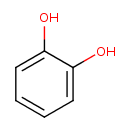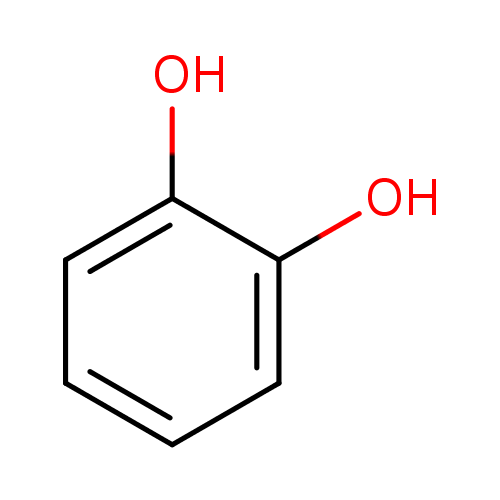|
Record Information |
|---|
| Version |
1.0 |
|---|
| Update Date |
1/22/2018 11:54:54 AM |
|---|
|
Metabolite ID | PAMDB110454 |
|---|
|
Identification |
|---|
| Name: |
catechol |
|---|
| Description: | A benzenediol comprising of a benzene core carrying two hydroxy substituents ortho to each other. |
|---|
|
Structure |
|
|---|
| Synonyms: | -
pyrocatechol
-
2-hydroxyphenol
-
pyrocatechin
-
1,2-dihydroxybenzene
-
1,2-benzenediol
|
|---|
|
Chemical Formula: |
C6H6O2
|
|---|
| Average Molecular Weight: |
110.11 |
|---|
| Monoisotopic Molecular
Weight: |
110.0367794368 |
|---|
| InChI Key: |
YCIMNLLNPGFGHC-UHFFFAOYSA-N |
|---|
| InChI: |
InChI=1S/C6H6O2/c7-5-3-1-2-4-6(5)8/h1-4,7-8H |
|---|
| CAS
number: |
120-80-9 |
|---|
| IUPAC Name: | benzene-1,2-diol |
|---|
|
Traditional IUPAC Name: |
catechol |
|---|
| SMILES: | C1(C=CC(=C(C=1)O)O) |
|---|
|
Chemical Taxonomy |
|---|
|
Taxonomy Description | This compound belongs to the class of organic compounds known as catechols. These are compounds containing a 1,2-benzenediol moiety. |
|---|
|
Kingdom |
Organic compounds |
|---|
| Super Class | Benzenoids |
|---|
|
Class |
Phenols |
|---|
| Sub Class | Benzenediols |
|---|
|
Direct Parent |
Catechols |
|---|
| Alternative Parents |
|
|---|
| Substituents |
- Catechol
- 1-hydroxy-4-unsubstituted benzenoid
- 1-hydroxy-2-unsubstituted benzenoid
- Monocyclic benzene moiety
- Organic oxygen compound
- Hydrocarbon derivative
- Organooxygen compound
- Aromatic homomonocyclic compound
|
|---|
| Molecular Framework |
Aromatic homomonocyclic compounds |
|---|
| External Descriptors |
|
|---|
|
Physical Properties |
|---|
| State: |
Solid |
|---|
| Charge: | 0 |
|---|
|
Melting point: |
105 °C |
|---|
| Experimental Properties: |
| Property | Value | Reference |
|---|
| Melting Point | 105 °C | Not Available | | Boiling Point | Not Available | Not Available | | Water Solubility | 461.0 mg/mL | Not Available | | LogP | 0.88 | HANSCH,C ET AL. (1995) |
|
|---|
| Predicted Properties |
|
|---|
|
Biological Properties |
|---|
| Cellular Locations: |
Not Available |
|---|
| Reactions: | |
|---|
|
Pathways: |
|
|---|
|
Spectra |
|---|
| Spectra: |
| Spectrum Type | Description | Splash Key | |
|---|
| GC-MS | GC-MS Spectrum - GC-EI-TOF (Pegasus III TOF-MS system, Leco; GC 6890, Agilent Technologies) | splash10-0udr-1950000000-16187bb35dcb40c26e78 | View in MoNA |
|---|
| LC-MS/MS | LC-MS/MS Spectrum - Quattro_QQQ 10V, Positive (Annotated) | splash10-01ox-9400000000-d59dce8c5e56b026f8b2 | View in MoNA |
|---|
| LC-MS/MS | LC-MS/MS Spectrum - Quattro_QQQ 25V, Positive (Annotated) | splash10-014i-9000000000-632cabc9b371835019c1 | View in MoNA |
|---|
| LC-MS/MS | LC-MS/MS Spectrum - Quattro_QQQ 40V, Positive (Annotated) | splash10-02t9-9200000000-ac902cb99981017de3b5 | View in MoNA |
|---|
| LC-MS/MS | LC-MS/MS Spectrum - EI-B (VARIAN MAT-44) , Positive | splash10-03di-8900000000-95af3d2738de98d27f26 | View in MoNA |
|---|
| LC-MS/MS | LC-MS/MS Spectrum - EI-B (Unknown) , Positive | splash10-03di-9600000000-032a40483dec93738075 | View in MoNA |
|---|
| LC-MS/MS | LC-MS/MS Spectrum - EI-B (HITACHI M-80) , Positive | splash10-03di-7900000000-f5cb1c53768e05ca1530 | View in MoNA |
|---|
| LC-MS/MS | LC-MS/MS Spectrum - LC-ESI-QTOF (UPLC Q-Tof Premier, Waters) , Negative | splash10-0a4i-0900000000-c94dab4d218dbb3bb108 | View in MoNA |
|---|
| LC-MS/MS | LC-MS/MS Spectrum - LC-ESI-QTOF (UPLC Q-Tof Premier, Waters) 30V, Negative | splash10-0a4i-1900000000-edd8ba1e77bbb2f76304 | View in MoNA |
|---|
| Predicted LC-MS/MS | Predicted LC-MS/MS Spectrum - 10V, Positive | splash10-03di-0900000000-66523f3122b954e6400f | View in MoNA |
|---|
| Predicted LC-MS/MS | Predicted LC-MS/MS Spectrum - 20V, Positive | splash10-03di-1900000000-5fd776e479836f7464af | View in MoNA |
|---|
| Predicted LC-MS/MS | Predicted LC-MS/MS Spectrum - 40V, Positive | splash10-0udi-9000000000-2c46a1375dbb634ef735 | View in MoNA |
|---|
| Predicted LC-MS/MS | Predicted LC-MS/MS Spectrum - 10V, Negative | splash10-0a4i-0900000000-986c93875cb12d90fa90 | View in MoNA |
|---|
| Predicted LC-MS/MS | Predicted LC-MS/MS Spectrum - 20V, Negative | splash10-0a4i-0900000000-a301685abb4194689ca3 | View in MoNA |
|---|
| Predicted LC-MS/MS | Predicted LC-MS/MS Spectrum - 40V, Negative | splash10-0a4i-9500000000-2017b42835ace86f16ee | View in MoNA |
|---|
| MS | Mass Spectrum (Electron Ionization) | splash10-03di-9600000000-b8e03f4f3ea89044828e | View in MoNA |
|---|
| 1D NMR | 1H NMR Spectrum | Not Available |
|---|
| 2D NMR | [1H,13C] 2D NMR Spectrum | Not Available |
|---|
|
|---|
|
References |
|---|
| References: |
- Topal S, Kocašaliskan I, Arslan O (2006)Herbicidal potential of catechol as an allelochemical. Zeitschrift fur Naturforschung. C, Journal of biosciences 61, Pubmed: 16610220
- Baldwin RW, Clegg JA, Curran AC, Austin EB, Khan T, Ma Y, Gunn B, Hudecz F, Byers VS, Lepoittevin JP, Price MR (1999)Regulation of the contact sensitivity response to urushiol with anti-urushiol monoclonal antibody ALG 991. Archives of dermatological research 291, Pubmed: 10651166
- Oikawa S, Hirosawa I, Hirakawa K, Kawanishi S (2001)Site specificity and mechanism of oxidative DNA damage induced by carcinogenic catechol. Carcinogenesis 22, Pubmed: 11470755
- Andersson MA, Hellman BE (2005)Different roles of Fpg and Endo III on catechol-induced DNA damage in extended-term cultures of human lymphocytes and L5178Y mouse lymphoma cells. Toxicology in vitro : an international journal published in association with BIBRA 19, Pubmed: 15951152
|
|---|
| Synthesis Reference: |
Lauterbach, Manfred; Zimmermann, Volker; Jaeger, Guenter; Radig, Wolfram; Adam, Johannes; Blady, Regina. Extraction and purification of pyrocatechol. Ger. (East) (1986), 4 pp. |
|---|
| Material Safety Data Sheet (MSDS) |
Download (PDF) |
|---|
|
Links |
|---|
| External Links: |
|
|---|


